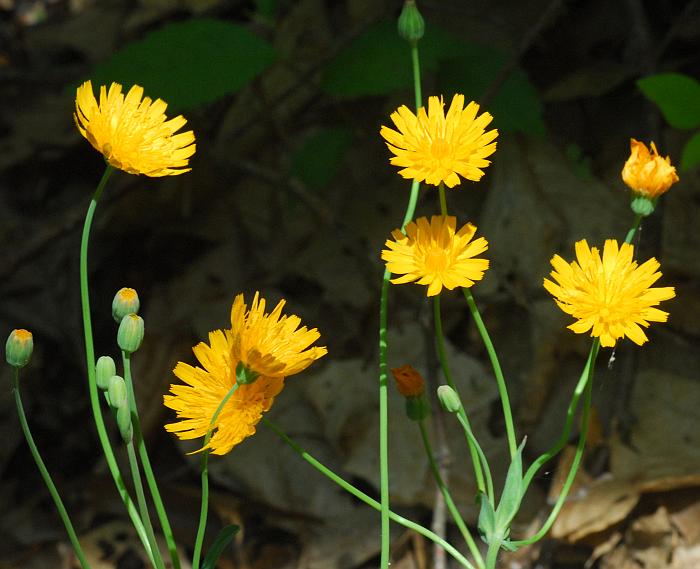Krigia biflora (Walter) S.F. Blake
Two-Flowered Cynthia

Native
CC = 5
CW = 3
MOC = 63
© SRTurner
Krigia biflora (Walter) S.F. BlakeTwo-Flowered Cynthia | |
 |
Native CC = 5 CW = 3 MOC = 63 |
© SRTurner |
|
Family - Asteraceae/Cichorieae Habit - Perennial forb with fibrous, sometimes fleshy roots and milky sap. Stems - Ascending to erect, to 60 cm, usually branched above the midpoint, glabrous or pubescent toward the tips with glandular hairs, glaucous. Leaves - Basal and usually 1-5 alternate along the lower stems, the primary branch point with 1 or 2 well-developed, bractlike leaves, the basal and lower stem leaves mostly petiolate (the petiole often winged), those higher on the stem abruptly different, sessile with rounded, clasping bases. Blades of basal and lower stem leaves 2-10 cm long, broadly obovate to oblong-oblanceolate, entire, wavy, toothed, or uncommonly shallowly lobed, the teeth spreading, mostly broadly triangular-pointed, the leaf tip rounded to bluntly pointed, the surfaces glabrous, usually at least the undersurface glaucous. Blades of median and upper stem leaves similar to the others but linear to narrowly oblong-ovate.
Inflorescence - Solitary terminal heads or open terminal clusters.
Heads - Involucral bracts 10-18, 7-11 mm long, lanceolate, flat, glabrous, withering and becoming reflexed with age.
Florets - Ligulate florets 25-60. Corollas 12-25 mm long, yellowish orange to orange, usually with 5 short terminal teeth. Pappus of 20-40 bristles and 10 short, inconspicuous scales, the bristles 4.0-5.5 mm long, off-white to light tan, the scales 0.3-0.5 mm long, mostly lanceolate, transparent.
Fruits - Achenes 2-3 mm long, cylindrical to slightly vase-shaped, more or less circular in cross-section, with 12-15 blunt, broad ribs, these microscopically roughened or barbed, reddish brown to dark brown.
Flowering - May - August. Habitat - Upland forests, prairies, pond margins, streambanks, pastures, roadsides. Origin - Native to the U.S. Lookalikes - K. dandelion. Flowering heads resemble those of many other members of the tribe, such as Hieracium, Sonchus, Hypochaeris, Taraxacum, Pyrrhopappus, etc. Other info. - This attractive species is often found in shaded forests, where it lends bright, colorful contrast to the dark forest floor. It is common across most of Missouri except for the northwestern quadrant, where it is uncommon or absent. Its U.S. distribution is primarily within the Midwest, with disjunct populations near the Four Corners region in the southwest. Photographs taken at Rockwoods Reservation Conservation Area, St. Louis County, MO, 5-22-2010, Valley View Glade Natural Area, Jefferson County, MO, 5-24-2014, and St. Joe State Park, St. Francois County, MO, 5-13-2015 (SRTurner). |